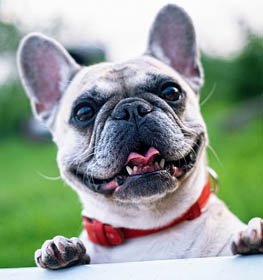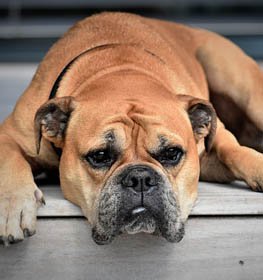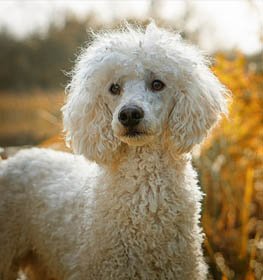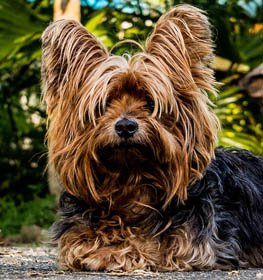Pekingi palotakutya fajtaleírás, jellemzői, tulajdonságai
Az alábbi adatlapon a Pekingi palotakutya kutyafajtával kapcsolatos komplex információkat találod, melyek alapján jobban megismerheted a fajtát. A kutya adatlapon a Pekingi palotakutya fajtaleírását, jellemzőit, tulajdonságait gyűjtöttük össze Neked.
| Csoport | Társasági kutyák |
|---|---|
| Ranglistán betöltött helyezés | 88 |
| Vélemények | 3 |
| Felhasználói értékelések | |
|
Pekingi palotakutya összehasonlítása más fajtákkal
Válassz legalább egy kutyafajtát az összehasonlításhoz. | |
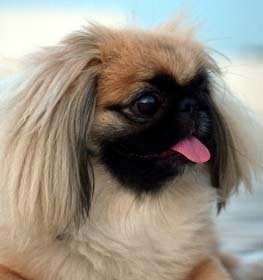 | |
| Származás | |
|
Egyéb nevek
Milyen más neveken hívják még a Pekingi palotakutya fajtát? | Pekingese, Chinese SpanielPekingese, Lion DogPekingese, PekePekingese, Peking PalasthundPekingese, Pelchie DogPekingese, Peking Lion Dog |
|---|---|
|
Fajta típusa
Keverék vagy fajtatiszta? | Fajtatiszta |
|
Méret
Mekkora méretű a Pekingi palotakutya? Milyen nagyra nőhet meg? | Kistermetű |
|---|---|
|
Súly
Hány kg lehet a Pekingi palotakutya fajta? | 3.6-4.5 kg |
|
Átlagsúly
Mennyi az átlagos súlya a kutyának? | 4 kg |
|
Magasság
Milyen magasra nőhet meg a Pekingi palotakutya? | 30-45 cm |
|
Átlagmagasság
Milyen magasra nőhet meg átlagosan a Pekingi palotakutya? | 19 cm |
|
Elérhetőség
Milyen könnyű hozzáférni/hozzájutni a kutyához? Milyen gyakorisággal fordul elő? |
|---|
|
Intelligencia
Mennyire okos a Pekingi palotakutya fajta? | Alacsony: A legalacsonyabb engedelmesség-intelligenciával rendelkezik a Pekingi palotakutya kutyafajta . Kitartóan kell tanítanod, ha szeretnéd lenyűgözni az embereket utasításokkal és trükkökkel. Ez a kutyafajta megérti és memorizálja az új parancsokat átlagosan 80-100 ismétlést követően. |
|---|---|
|
Taníthatóság
Mennyire könnyű a Pekingi palotakutya nevelése / taníthatósága? | Könnyű kiképezni: a Pekingi palotakutya olyan kutyafajta, mely könnyedén tanítható. Nagyon gyorsan megtalálják a parancsok és a tevékenységek közötti összefüggéseket. |
|
Házőrző képesség
Mennyire jó házőrző típus a Pekingi palotakutya? | Átlagos házőrző kutyafajta a Pekingi palotakutya. Ha valami szokatlant érzékel, figyelmeztet, de a megfigyelést nem tekinti fő feladatának. |
|
Területvédelem
Mennyire védi területét a Pekingi palotakutya? | Erősen védi területét a Pekingi palotakutya. Ez a kutyafajta olyan, mint egy biztonsági őr. Veszély esetén lehet rá számítani. |
|
Temperamentum
Milyen természete van a Pekingi palotakutya fajtának? Milyen a vérmérséklete? | KonokIntelligensSzeretetteljesAgresszívJó természetűÖnfejű |
|---|---|
|
Érzékenység
Mennyire érzékeny lelkű kutya a Pekingi palotakutya? | Kevésbé érzékenyek, mint más kutyafajták. A fegyelmezés érzelmileg kevésbé érinti meg őket. Jól fogadják a szabálytalan napi rutint, a kisgyermekek hangoskodását, a zajos környezetet, többnyire az irodai környezetet és a gyakori vendéglátást. |
|
Érzelmek kifejezése
Mennyire mutatja ki érzelmeit a kutyafajta? | Imádja az embereket: a Pekingi palotakutya hűséges, lágyszívű, szelíd, szerető és gondoskodó kutya különösen a gazdái iránt. Élvezik a minőségi időt a gazdikkal, és nagyszerű terápiás kutyák válhatnak belőlük. Ez a fajta érzékeny a gazdi érzelmeire, mert szorosan kötődik hozzá. Ha boldog és kiegyensúlyozott vagy, akkor garantáltan ő is az. |
|
Szocialitás
Mennyire igényli az emberek társaságát? | Átlagos: a Pekingi palotakutya fajta szereti a társaságot, ugyanakkor kisebb-nagyobb időintervallumra az egyedüllétet is jól tolerálja. |
|
Kóborlási potenciál
Mennyire szeret elkóborolni a Pekingi palotakutya? Mennyire szeret felfedezni és vándorolni? | Közepes: a Pekingi palotakutya átlagos vándorlási potenciállal rendelkezik. Időnként szeretik felfedezni a világot és előfordulhat, hogy néha el is szöknek, ugyanakkor általában az otthon adta biztonságot jobban preferálják. Legjobb, ha megtanítod neki, hogy utasításra visszatérjen. |
|
Ragadozó ösztön
Mennyire ragadozó típus? Veszélyes lehet más állatokra a Pekingi palotakutya? | Nagyon magas: a Pekingi palotakutya kiemelkedő ragadozói ösztönnel rendelkezik, amit azt jelenti, hogy nagy késztetést érez arra, hogy kisállatokat (macskát vagy más apró állatot) elkapjon vagy üldözzön. Jobb, ha ezt a fajtát kisállatok közelében pórázon tartod. Átfogó képzéssel az ösztön kontrollálható és elérhető a helyes viselkedés. |
|
Ugatás
Mennyit ugat a Pekingi palotakutya? | Gyakori: a Pekingi palotakutya sűrűn ereszti ki a hangját. Nem a legjobb választás, ha inkább egy csendes fajtát szeretnél. Gyakran hangosan ugatnak. Az ugatás legfontosabb kiváltó okai: félelem, figyelemfelkeltés, riasztás, unalom, üdvözlés, szeparációs szorongás, kényszeres ugatás és védekezés. |
|---|---|
|
Játékosság
Mennyire játékos típus a Pekingi palotakutya? | Nem igazán szeretnek játszani. Ha boldoggá akarod tenni, más aktivitást kell keresned. |
|
Lakásban tartható
Lakásbarát kutya a Pekingi palotakutya? Lakásban tartható kutya? Jól érzi magát a Pekingi palotakutya lakásban? | Kimondottan lakásbarát kutya a Pekingi palotakutya fajta. Jó, ha van egy kis kerted, ahová néha kimehet elintézni dolgát, ugyanakkor ez egyáltalán nem fontos. Napi egy-két sétával kellőképpen lemozgathatod. |
|
Alkalmazkodó képesség
Mennyire tud alkalmazkodni a változásokhoz a Pekingi palotakutya? | Kiválóan alkalmazkodik az életmód-változásokhoz és a különböző életkörülményekhez. Jól tolerálják a költözéseket. |
|---|---|
|
Egyedüllét tolerancia
Egyedül hagyható a Pekingi palotakutya? | Csakúgy, mint minden kölyökkutya, hajlamosak nyafogásra, pánikra, sírásra, ugatásra, amikor a gazdi egyedül hagyja. Megfelelő szocializáció és minőségi együtt töltött idő a kutyával megoldhatja ezt a problémát. |
|
Harapási potenciál
Mennyi esély van arra, hogy megharaphat másokat a Pekingi palotakutya? | Alacsony Kevés esély van arra, hogy a Pekingi palotakutya megharap valakit. A kutya harapásának fő okai: fájdalom, izgalom, terelési ösztön, provokálás és önvédelem. ( Az adatok a rendelkezésre álló online harapási statisztikákon alapulnak.) |
|---|---|
|
Harapdálás és rágcsálás
Mennyire jellemző a harapdálás a Pekingi palotakutya fajtára? Szeret rágcsálni? | Közepes: a Pekingi palotakutya átlagos hajlandóságot az emberek rágására, játékos harapására vagy csipkelődésére. Kölyökkorban ez a szokás nem agresszív viselkedésnek tudható be, hanem teljesen normális. Ezek a harapások ártalmatlanok, de jobb ha időben leszoktatod róla a kutyát. |
| Harapási erő | Átlagtól gyengébb (7-14 bar között) |
|
Várható élettartam
Meddig él egy a Pekingi palotakutya? | 13-15 év |
|---|---|
|
Időjárás és éghajlat
Milyen időjárást szeret a legjobban? | Előnyben részesíti az átlagos és a hideg időjárást |
|
Egészség
Mennyire egészséges kutyafajta a Pekingi palotakutya? | Általában egészséges kutyafajta a Pekingi palotakutya. Az állatorvosi költségei várhatóan nem lesznek túl magasak. |
|
Egészségügyi ellenőrzés
Milyen gyakran kell állatorvoshoz vinni? | Ritka a Pekingi palotakutya kutyafajtát egy vagy másfél évente legalább egyszer teljes körű egészségügyi vizsgálatnak kell alávetni. Ha a kutya bármilyen tünetet mutat, hívd fel állatorvosodat. |
|
Egészségügyi problémák
Milyen betegségekre hajlamos a Pekingi palotakutya fajta? Milyen egészségügyi problémái lehetnek? | SzürkehályogTérdkalács ficamProgresszív retina atrófia (PRA)Szemhéjbefordulás, álmosszeműség Hát-ágyéki porckorongsérv (a csigolyaközti porckorong degeneratív betegsége, IVDD)Szaruhártya megbetegedés (EKS)Kétsoros pillaszőrökKéthegyű billentyű elégtelenségRejtettheréjűségSzempilla rendellenesség A szempilla a szemhéj belső felületén növekszik. A rövid orrú, lapos arckoponyájú (brachicephal) fajtájú kutyákban és macskákban előforduló részleges felső légúti szűkület. |
|
Energia szint
Energikus kutya a Pekingi palotakutya? Mennyi aktivitásra van szüksége? | Alacsonyabb energiaszinttel rendelkeznek a Pekingi palotakutya, mint más kutyák. Ha nyugodt életet élsz, akkor jó döntés lehet ez a kutyafajta. |
|---|---|
|
Mozgásigény
Mennyi aktivitást igényel a Pekingi palotakutya? Mennyit kell mozgatni, sétáltatni egy nap a kutyafajtát? | Minimális: a Pekingi palotakutya mozgásigénye minimális. Ha lassabb, esetleg lustább életet élsz, akkor jó választás lehet ez a kutyafajta. |
|
Alvásigény
Mennyit alszik egy nap a Pekingi palotakutya? | Szeret aludni, így viszonylag sokat is alszik. Nem a legaktívabb kutyafajta. Ha aktív életet élsz, ez a kutyafajta rossz választás lehet neked. |
|
Hízékonyság
Mennyire hízékony kutyafajta a Pekingi palotakutya? | Közepes: a Pekingi palotakutya elhízási kockázata átlagosnak tekinthető. A napi sétákat érdemes rutinszerűen és ütemezetten megtenni. Annak érdekében, hogy kutyád boldog és fitt legyen, tápláld minőségi száraz kutyaeledellel. Éljetek együtt aktív életet, hiszen ez mindkettőtök érdeke. Találd meg az egyensúlyt a testmozgás és a táplálkozás között. Ha nagyobb súlyváltozást észlelsz, konzultálj állatorvosoddal. Szükség esetén készíttess étkezési tervet, és rendszeresen mérd vissza a Pekingi palotakutya súlyát. |
|---|---|
|
Etetése
Mennyi ételt kell adni a kutyának? Hogyan zajlik a Pekingi palotakutya etetése?
(Felnőtt kutyára számított mérték, a Pekingi palotakutya kölyök etetése ettől eltérhet.) | Ajánlott napi mennyiség: 25-50 g kiváló minőségű száraz kutyatáp, egy-két étkezésre felosztva. |
|
Hipoallergén
Hipoallergén kutyafajta a Pekingi palotakutya? Okozhat a kutya allergiás tüneteket? | Nem Allergiás reakciókat vált ki a Pekingi palotakutya. Azonban számos olyan fajta létezik, aki csökkenti vagy minimalizálja az allergiás tünetek lehetőségét. Az allergiás reakciók kiváltásának szempontjából a szőrzet típusa nem feltétlenül releváns, mivel a legtöbb allergén a szőrön, illetve a bőrön lévő pelyhekben vagy a nyálban található. |
|---|---|
|
Színek
Milyen színváltozatokban fordulhat elő, melyek a Pekingi palotakutya színei? A következő színek a leggyakoribbak: | FeketeSzürkeVörösKrémszínűFehérBarna, fekete szőrzettel az arcon és a füleken |
|
Ápolás, tisztántartás
Milyen rendszeresen kell ápolni a Pekingi palotakutya fajtát? | Profi: a Pekingi palotakutya kutyafajta sok munkát igényel, ahhoz hogy jó állapotban tartsd. Napi ápolást igényel. Alapvető fontosságú a kutya szőrének vágása egy profi ápoló készlettel. A kutya szőrzetének mindennapos tisztítása szükséges a lerakódások csökkentése érdekében. A füleket és a szemét rendszeresen meg kell tisztítani a fertőzések elkerülése érdekében. Sose hagyd ki a szezonális bolhakezelést. A kutya körömvágásának és a kutyás fürdésnek heti ütemtervnek kell lennie. A megfelelő gondozás sokba kerül, időigényes és kiváló ápolási képességeket igényel. Ha nincs időd, készséged, akkor az a legjobb, ha kutyakozmetikához vagy vágószalonhoz fordulsz. |
|
Nyáladzás
Mennyire nyáladzik a Pekingi palotakutya? | Alacsony: a Pekingi palotakutya tökéletes példája a minimális nyáladzásnak. Ha nehezen viseled a ruháidon felbukkanó nyálfoltokat, akkor ez a kutyafajta jó választás lehet. A nyáladzás a fajta jellegzetességéhez tartozik egyes kutyafajtáknál, ugyanakkor mentális (pl. stressz, szorongás) vagy fizikai egészségügyi problémára is felhívhatja a figyelmet. Ha bármilyen változást észlelsz a kutya nyáladzási szokásában, akkor fordulj állatorvoshoz. |
|
Kellemetlen szagok kockázata
Mennyire lehet büdös a Pekingi palotakutya? | Magas Magas a kockázat arra, hogy a Pekingi palotakutya kellemetlen szagú legyen. A kutya büdösségének gyakori okai: a rossz fogak, fül vagy a bőrredők fertőzése, bélgázok. |
|
Szőrzet típusa
Milyen típusú bundája van a Pekingi palotakutya fajtának? | Sűrű |
|
Fürdetési gyakoriság
Milyen gyakran kell fürdetni? | 4-6 hetente Átlagos |
|
Vedlési szint
Mennyit vedlik a Pekingi palotakutya? Sok szőrt hullat a kutyafajta? | Átlagos: a Pekingi palotakutya szőrhullása a kutyafajták között normálnak mondható. A szőrhullás vagy szőrváltás egy természetes ciklus folyamatának része. A mennyisége függhet a kutya korától, egészségügyi állapotától és fajtájától is. |
|
Gyerekbarát
Mennyire szereti a gyerekeket a Pekingi palotakutya fajta? | Nem gyerekbarát a Pekingi palotakutya fajta. Nem javasolt kisgyermekes családok számára. |
|---|---|
|
Háziállat-barát
Mennyire jön ki jól más háziállatokkal? | a Pekingi palotakutya kutyák a legbarátságosabb kutyafajták közé tartoznak. |
|
Idegenbarát
Az idegenekkel barátságos a Pekingi palotakutya? | Átlagosan viselkedik az idegenekkel a Pekingi palotakutya fajta. |
|
Macskabarát
Macskabarát kutyafajta a Pekingi palotakutya? | Imád a macskákkal együtt élni a Pekingi palotakutya. |
|
Kutyabarát
Mennyire szeret más kutyákkal lenni a Pekingi palotakutya? | Átlagosan viselkedik más kutyákkal a Pekingi palotakutya. |
|
Kezdő gazdiknak
Elsőkutyás gazdiknak ajánlható a Pekingi palotakutya? | Igen a Pekingi palotakutya kutyák jó választásnak bizonyulnak kezdő gazdik számára, mivel könnyen kezelhető személyiséggel rendelkeznek. |
|
Irodabarát
Tartható irodában a Pekingi palotakutya? Jellemzően szereti az irodakutya életstílust a kutyafajta? | Nem Nem igazán kedveli az irodai környezetet. |
|
Idősbarát
Idősbarát kutya? Jól kijön az idősebb korosztállyal? | Nem javasolt idős emberek mellé. |
|
Szolgálati kutya
Alkalmazzák szolgálati kutyának a Pekingi palotakutya fajtát? | Nem jellemző Nem jellemző, hogy szolgálati kutyának képezzék és alkalmazzák a Pekingi palotakutya fajtát. A szolgálati kutya olyan kifejezés, amelyet az USA-ban kezdtek el használni, olyan segítő kutyák meghatározására, amelyek kifejezetten fogyatékossággal élő embereknek képeztek: látássérültek, hallássérültek, mentális rendellenességgel élők, mozgáskorlátozottak és cukorbetegek. |
|---|---|
|
Terápiás-segítő kutya
Alkalmazzák a kutyafajtát, mint terápiás-segítő kutyát? Segít a Pekingi palotakutya a fejlesztő foglalkozások kivitelezésében? | Nem jellemző Nem megszokott, hogy a Pekingi palotakutya kutyafajtát terápiás célokra alkalmazzák. A terápiás kutya olyan kutya, amelyet arra képeztek ki, hogy szeretettel fizikai vagy lelki segítséget tudjon nyújtani kórházakban, rekreációs célú egészségügyi intézményekben, időskorúak otthonában, iskolákban, vendéglátóhelyeken, katasztrófahelyzetekben, valamint szorongásos vagy autizmussal élők számára. |
|
Kereső vagy nyomkövető eb
Alkalmazzák kereső vagy nyomkövető kutyaként a Pekingi palotakutya fajtát? | Nem jellemző Nem jellemző, hogy alkalmaznák őket ilyen típusú feladatokra, ugyanakkor lehetnek kivételes esetek. A felderítő kutya vagy a kábítószer-kereső kutya olyan kutya, akit arra tanítottak, hogy érzékeit (főleg szaglását) használja fel olyan anyagok kimutatására, mint például csempészett elektronika (pl. mobiltelefonok), robbanóanyagok, illegális drogok, pénz és vér. Nem jellemző választás a Pekingi palotakutya kutyafajta a fenti célokra. |
|
Kereső- és mentőkutya (SAR)
Alkalmazzák kereső és mentőkutyaként? | Nem jellemző Nem jellemző, hogy kereső és mentőkutyaként alkalmaznák a kutyafajtát. A kutyák kutatásban és mentésben történő felhasználása (search and rescue, SAR) értékes nyomkövető segítség, kifejezetten a természeti katasztrófák és a súlyos veszteségekkel járó események, valamint az eltűnt személyek felkutatása során. Nem a legjobb fajta kereső- és mentőkutya célokra, feladatokra a Pekingi palotakutya. |
|
Vízkedvelő kutyafajta?
Szeret vízben lenni a Pekingi palotakutya? Szeret csónakázni? | Nem jellemző Ez a kutyafajta általában nem szeret hajón tartózkodni, mivel vízbiztonságuk kevesebb, mint a víz-imádó kutyáknak. |
|
Szánhúzó vagy teherhúzó kutya
Jó szánhúzó kutya lenne a Pekingi palotakutya? | Nem jellemző A tehervontató kutyákat arra tenyésztették, hogy különböző dolgokat szállíttassanak velük egy hozzájuk csatolt kocsin. A munkához tenyésztett kutyák izmos felépítésűek, megfelelő erővel és elszántsággal rendelkeznek. Nem a legjobb fajta tehervontatásra a Pekingi palotakutya. |
|
Harci kutya
Alkalmazták a történelem során harci kutyaként a Pekingi palotakutya fajtát? | Nem volt jellemző Szerencsére a történelem során ezt a fajtát nem alkalmazták harci-kutyának. |
|
Átlagos alomszám
Mennyit ellik a Pekingi palotakutya? Hány kölyke születik átlagosan? | 2-4 kölyök |
|---|---|
|
Vemhesség hossza
Meddig vemhes a Pekingi palotakutya fajta? | 60-64 nap A nőstény reprodukciós (szaporodási) ciklusa: A Proestrus nevű első időszak nagyságrendileg 9 napig tart. Ez idő alatt a nőstények kankutyákat vonzanak. A vulva duzzadása és véres folyása észlelhető. A második rész az Estrus, amikor a szuka fogékony a kan számára. Ez az időszak nagyságrendileg 3-11 napig tart. A folyás csökken és színe világosabbá válik. A harmadik rész a Diestrus: általában a 14. nap körül fordul elő. Ebben az időszakban a szuka menstruációs folyása élénkvörösre változik, és a végére ér. A vulva visszatér az eredeti állapotába és ettől kezdve párzásra nem alkalmas. A negyedik részt Anestrusnak hívják: a tüzelési időszakok közötti időtartam, mely általában hat hónapig tart. |
|
Ellési gyakoriság
Milyen gyakran lehetnek kölykei a Pekingi palotakutya fajtának? Milyen gyakran születhetnek kiskutyái? | Egyszer egy évben. A gyakoribb tenyésztés nem egészséges. Nagyon fontos, hogy ne vásárolj kutyát egy kölyöküzemből / tenyészettől, ahol a Pekingi palotakutya kölykök és az anyák szükségleteit nem veszik figyelembe. Nem javasoljuk, hogy olyan tenyésztőtől (szaporítótól) vásárolj kutyát, ahol egy évben többször születnek kölykök. Ez egy embertelen, nagy volumenű szaporító tevékenység, ami egyáltalán nem minősül elfogadható állattenyésztésnek. |
|
AKC csoport
Melyik AKC csoportba tartozik a Pekingi palotakutya fajta? | Az American Kennel Club által elismert kutyafajták közé tartozik. Az AKC a fajtát 1906-ban az aprótermetű kutyák csoportjába sorolta be. |
|---|---|
|
FCI csoport
Melyik FCI csoportba tartozik a Pekingi palotakutya? | Az FCI által elismert kutyafajták közé tartozik, a társasági kutyák csoportjába, azon belül a japán csin és pekingi palotakutya szekciójába. |
|
Fajtaelismerő szervezetek
Mely szervezetek ismerik el a kutyafajtát? | American Canine RegistryAmerican Kennel ClubAmerica's Pet RegistryCanadian Kennel ClubDog Registry of America Inc.Federation Cynologique InternationaleKennel Club of Great BritainNorth American Purebred Registry, Inc.American Canine Association, Inc.Australian National Kennel CouncilNational Kennel ClubNew Zealand Kennel ClubUnited Kennel ClubPekingese Club Of America |
Pekingi palotakutya előnyök és hátrányok
Előnyök
- Taníthatóság: Könnyű kiképezni: a Pekingi palotakutya olyan kutyafajta, mely könnyedén tanítható.
- Egészség: Általában egészséges kutyafajta a Pekingi palotakutya.
- Lakásban tartható: Kimondottan lakásbarát kutya a Pekingi palotakutya fajta.
- Nyáladzás: Alacsony: a Pekingi palotakutya tökéletes példája a minimális nyáladzásnak.
- Alkalmazkodó képesség: Kiválóan alkalmazkodik az életmód-változásokhoz és a különböző életkörülményekhez.
- Macskabarát: Imád a macskákkal együtt élni a Pekingi palotakutya.
Hátrányok
- Intelligencia: Alacsony: A legalacsonyabb engedelmesség-intelligenciával rendelkezik a Pekingi palotakutya kutyafajta .
- Ápolás, tisztántartás: Profi: a Pekingi palotakutya kutyafajta sok munkát igényel, ahhoz hogy jó állapotban tartsd.
- Gyerekbarát: Nem gyerekbarát a Pekingi palotakutya fajta.
- Idősbarát: Nem javasolt idős emberek mellé.
Pekingi palotakutya legutóbbi összehasonlításai
Pekingi palotakutya nevek
Mennyi idős emberi években egy Pekingi palotakutya?
Neked ajánlott
Pekingi palotakutya értékelés
Pekingi palotakutya kommentek, értékelések, kérdések
- Nagy Lívia
2024. jan. 14. 20:43:24:
Imádni való ez a kis kutyuska! Aranyos társ lehet. Szerintem nem csúnya, cuki azzal a kis nyomottabb fejével.
- Albert Csaba
2020. nov. 16. 8:43:46:
Nekem kell egy ilyen kutyus!

